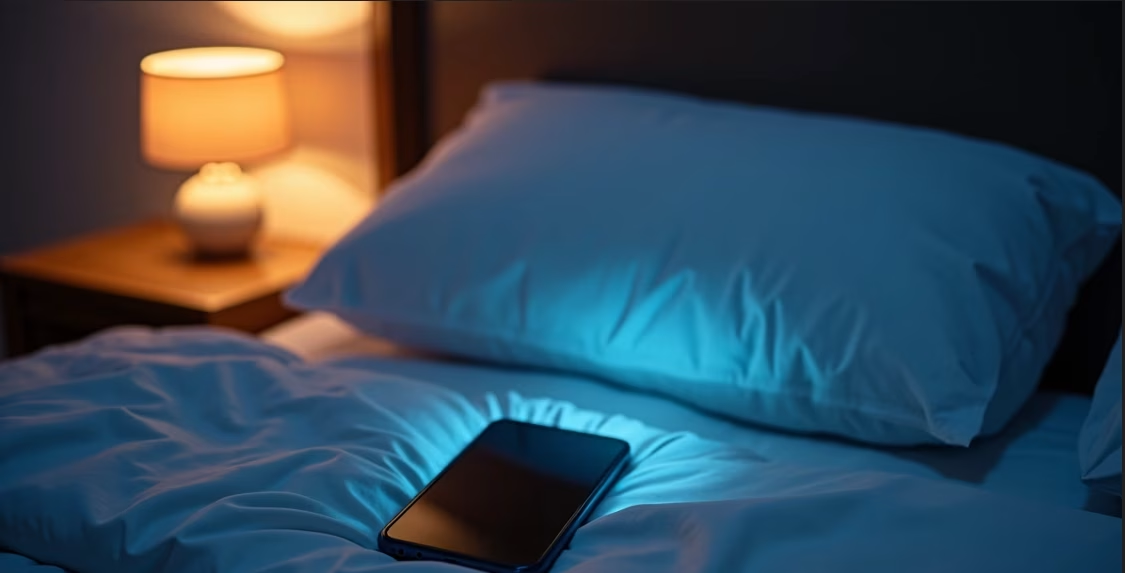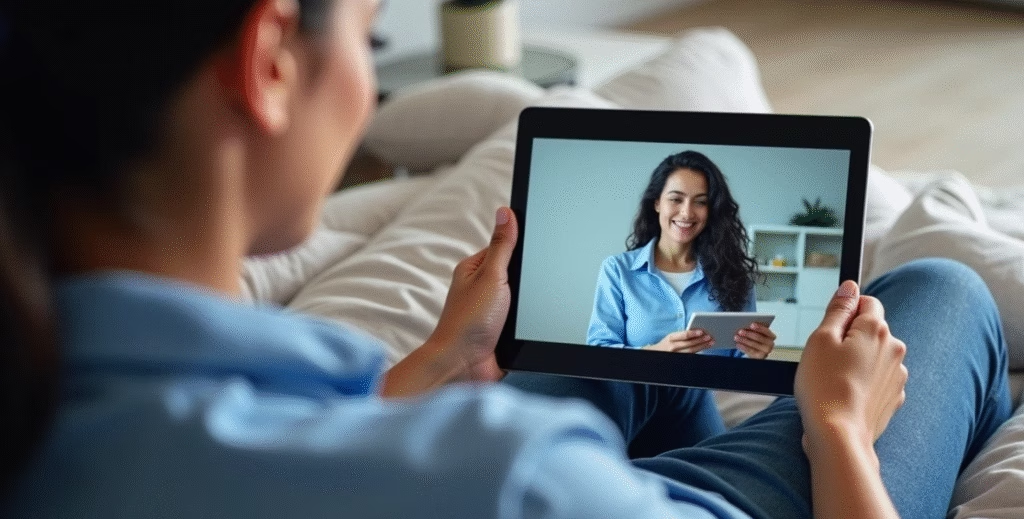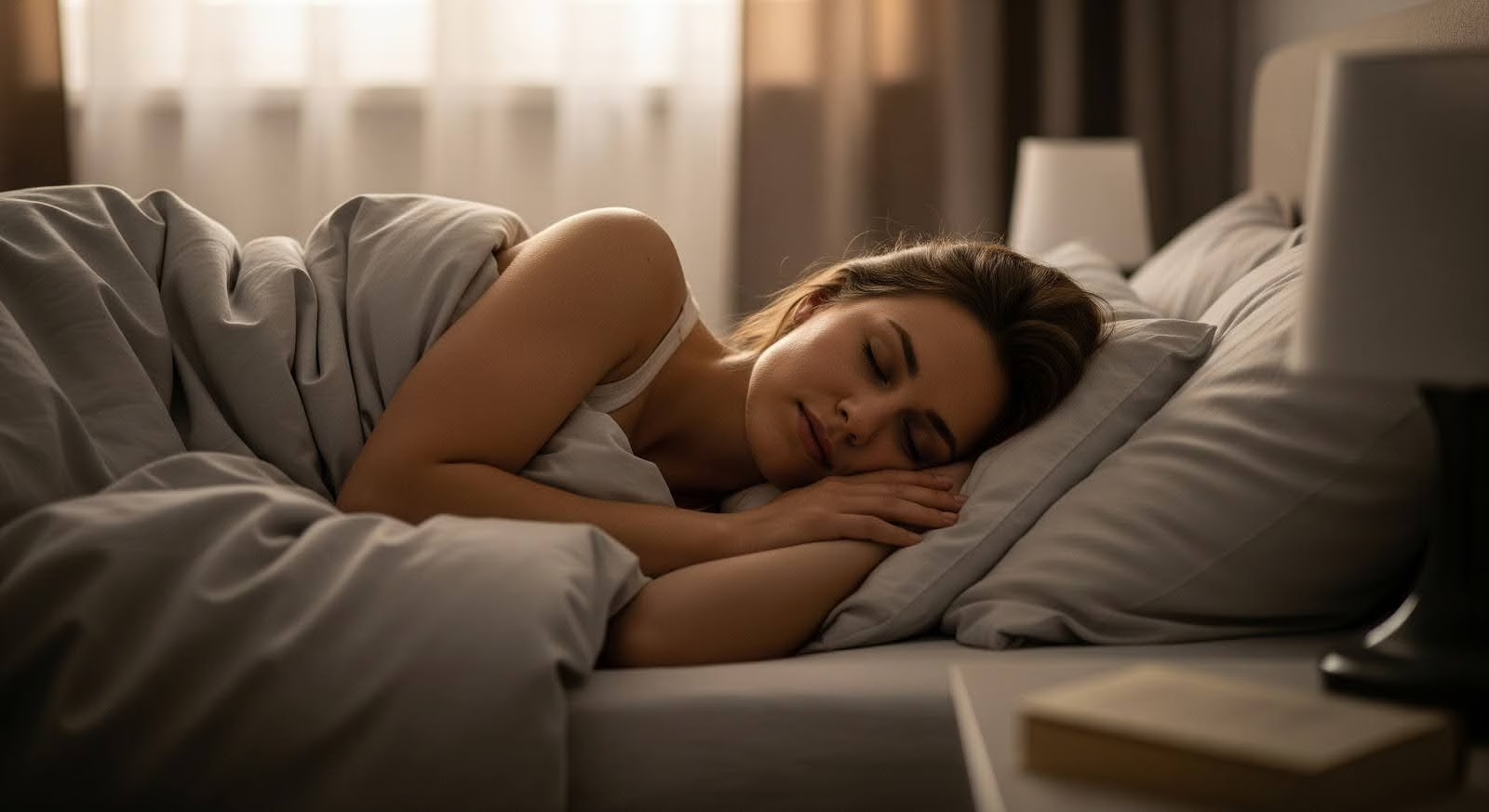
Sleep problems sabotage recovery efforts for many people working to overcome addiction.
When insomnia goes untreated during early abstinence, patients are far less likely to complete treatment programs. A 2019 study found that higher insomnia severity predicted lower odds of finishing intensive outpatient care, directly increasing relapse risk.
This article explains how telehealth sleep interventions, especially cognitive behavioral therapy for insomnia, can protect recovery by addressing one of the most overlooked predictors of relapse.
The Link Between Sleep and Relapse
Sleep disturbance is nearly universal among people entering substance use disorder treatment. Most new patients in intensive programs show clinically significant insomnia and poor sleep quality at intake, yet this critical symptom often goes untreated. The consequences are measurable and serious. Researchers tracking intensive outpatient program completion found that insomnia severity, as measured by the Insomnia Severity Index, was the sleep metric that predicted who would drop out before finishing treatment. Poor sleep quality and daytime sleepiness did not carry the same predictive weight.
Why does insomnia undermine recovery so powerfully? Sleep deprivation disrupts the brain regions responsible for impulse control, emotion regulation, and decision making. When someone is chronically exhausted, their ability to resist cravings weakens. Negative emotions intensify. The prefrontal cortex, which helps us choose long term goals over immediate relief, functions poorly without adequate rest. Insomnia also creates a vicious cycle: people may turn back to substances to self medicate their sleep problems, or develop unhelpful beliefs like “I can’t sleep without something to help me.”
The pathway from poor sleep to relapse runs through treatment engagement. When patients are too tired to focus in therapy sessions, when they miss groups because they overslept after a sleepless night, when irritability from exhaustion strains their relationships with counselors and peers, they are at risk of leaving treatment early. And leaving treatment early is one of the strongest predictors of relapse.
Why Traditional Sleep Medications Fall Short?
Many clinicians hesitate to prescribe sedative hypnotics for people in addiction recovery, and for good reason. These medications can become a new dependence, they alter sleep architecture in ways that reduce restorative sleep, and they carry risks like next day impairment and complex sleep behaviors. For someone working to break free from substance dependence, swapping one chemical solution for another misses the opportunity to rebuild natural sleep capacity.
CBT-I: The Gold Standard Sleep Intervention
Cognitive behavioral therapy for insomnia is a structured, non pharmacologic treatment that addresses the root causes of chronic insomnia. Unlike sleep medications, which suppress symptoms, CBT-I retrains the brain and body to sleep naturally by changing behaviors, thoughts, and sleep patterns. The approach typically unfolds over six to eight sessions and includes several core components that work together.
Sleep restriction therapy consolidates sleep by limiting the time spent in bed to match actual sleep time, then gradually expanding the window as sleep efficiency improves. This creates healthy sleep pressure and breaks the association between bed and wakefulness. Stimulus control therapy reinforces bed as a place for sleep, not for lying awake. Patients learn to go to bed only when sleepy and to get out of bed if they have been awake for more than 15 or 20 minutes. Cognitive therapy identifies and challenges unhelpful beliefs about sleep, such as catastrophic thinking about the consequences of a bad night or the conviction that sleep is impossible without medication.
Sleep hygiene education covers environmental and behavioral factors like caffeine timing, light exposure, bedroom temperature, and device use. The final sessions always include relapse prevention planning, teaching patients to recognize triggers for sleep disruption and how to quickly apply the skills they have learned. This is especially relevant in addiction recovery, where life stressors can spike and relapse prevention for sleep and substance use often intersect.
A large network meta analysis across 241 trials found that CBT-I provided the highest likelihood of insomnia remission. The analysis identified sleep restriction and cognitive restructuring as particularly powerful components. Importantly, CBT-I works across delivery formats: individual therapy, group therapy, and telehealth all show strong outcomes.
Group CBT-I in Addiction Treatment Settings
For programs treating substance use disorders, group CBT-I offers a practical way to reach multiple patients at once. A study using the RE-AIM implementation framework tested group CBT-I in an outpatient clinic embedded in a therapeutic community. The program achieved 96.5 percent consent and 80 percent attendance at the first session. Half of the counselors completed training, demonstrating that adoption is feasible within existing staff. Participants reported improved sleep continuity, efficiency, and total sleep time.
The same study highlighted a useful adaptation: Brief Behavioral Treatment for Insomnia, or BBTI, condenses the protocol into fewer sessions with less training burden. This makes it easier for addiction counselors without specialized sleep training to deliver effective behavioral sleep interventions. Embedding sleep care into existing weekly group therapy slots reduces scheduling friction and normalizes sleep as a recovery priority.

Telehealth in Addiction Treatment Expands Access
Telehealth has become a core modality in Georgia’s addiction care continuum. Federal policy changes in recent years have enabled remote prescribing of medications for opioid use disorder and extended telemedicine flexibilities for other controlled substances through the end of 2025. In January 2025, the DEA and HHS finalized a permanent telemedicine pathway for buprenorphine prescribing, allowing both audio only and audio video encounters. This regulatory foundation supports the integration of telehealth sleep care within addiction treatment programs.
Georgia Medicaid permits telehealth for behavioral health services when delivered via live video and when providers meet explicit technical and credentialing standards. Commercial payer policies vary. UnitedHealthcare has committed to continuing Medicare Advantage telehealth benefits through 2026, while Aetna discontinued coverage for virtual intensive outpatient and partial hospitalization programs in 2024. This uneven payer landscape means that programs offering tele CBT-I must verify coverage carefully and build flexible contracting strategies.
Evidence supports the clinical effectiveness of virtual intensive outpatient programs. One large health system reported comparable or better patient improvement scores in virtual IOP cohorts compared with in person groups, based on tens of thousands of visits. Patients often feel more comfortable disclosing sensitive information from home, and the elimination of travel barriers improves attendance for people in rural areas or those with transportation challenges.
Practical Considerations for Virtual Sleep Therapy
Delivering CBT-I via telehealth requires a stable internet, a device with video capability, and a private space where the patient can speak freely. Group sessions typically run three hours and meet multiple times per week, mirroring in person curricula. Providers must ensure secure platforms that comply with HIPAA and maintain robust documentation of each encounter, including the modality used and any adaptations made for remote delivery. Georgia’s telehealth policies require that practitioners hold appropriate state licensure and work within their scope of practice, whether treating patients via video or audio only modalities where permitted.
Measuring Sleep to Track Recovery Outcomes
Routine measurement transforms sleep from a vague complaint into an actionable treatment target. The Insomnia Severity Index is a seven item questionnaire that captures severity, distress, and functional impact. It is validated, brief, and sensitive to change, making it ideal for addiction treatment settings. Administering the ISI at intake and every two to four weeks during treatment allows clinicians to identify high risk patients, adjust interventions, and demonstrate progress.
Meaningful clinical response is often defined as a reduction of seven or more points on the ISI, while remission is typically an ISI score below eight to ten. Tracking these benchmarks alongside substance use outcomes, such as program completion and abstinence rates, helps programs quantify the indirect benefit of treating sleep. When patients sleep better, they stay in treatment longer, and longer treatment stays predict better long term recovery.
The Pittsburgh Sleep Quality Index and Epworth Sleepiness Scale provide complementary information about sleep quality and daytime function, but the ISI is the most predictive tool for treatment engagement during early abstinence. Programs should also screen for obstructive sleep apnea using tools like the STOP-BANG questionnaire, since untreated apnea can worsen insomnia and undermine recovery efforts.
Georgia Resources for Sleep and Recovery
| Resource | Location | Key Features | When to Use |
| Emory Sleep Center | Atlanta | AASM accredited; home sleep apnea testing and in lab studies; two week scheduling | Rapid evaluation of suspected sleep apnea or other sleep disorders |
| AASM Accredited Centers | Statewide | Gold standard accreditation; stringent quality and safety standards | Diagnostic testing and treatment planning for complex sleep problems |
| Telehealth CBT-I Networks | Statewide | Georgia licensed therapists provide virtual sleep therapy | When local behavioral sleep specialists are unavailable |
| Virtual IOP Programs | Statewide | Deliver intensive outpatient addiction care remotely | For patients who need structured treatment but face travel barriers |
Georgia maintains multiple AASM accredited sleep centers, including facilities in Atlanta and Athens that accept Medicaid, Medicare, and commercial insurance. These centers can rapidly diagnose and treat obstructive sleep apnea, a common comorbidity that overlaps with insomnia and complicates recovery. When a patient screens positive for apnea risk, referral to an accredited center ensures quality evaluation and access to proven treatments like positive airway pressure devices or oral appliances.
The state’s broadband program is nationally recognized for its detailed mapping and investments in rural connectivity. This infrastructure supports telehealth delivery of both addiction treatment and sleep interventions, though gaps remain in some rural areas. Programs should assess patients’ access to reliable internet and offer contingency plans, such as audio only sessions or community based access points, when video is not feasible.
Digital Sleep Apps and Coverage Realities
Prescription digital therapeutics like Somryst offer another avenue for CBT-I delivery. The app is FDA cleared and delivers a nine week program based on established CBT-I principles. Real world analyses have reported improved insomnia severity scores and potential reductions in emergency department visits and overall health care costs. However, payer coverage is inconsistent. Several AmeriHealth Caritas Medicaid plans deem Somryst investigational, citing availability of alternative therapies like clinician delivered CBT-I.
A one year study of patients using a mobile CBT-I app combined with medication tracked long term outcomes and found that a substantial subset experienced relapse, underscoring the need for durable relapse prevention strategies within digital interventions. Another pilot study of a sleep app for shift workers observed high dropout rates, illustrating the engagement challenges that plague many mobile health applications.
These findings suggest that digital CBT-I is a useful tool but not a standalone solution. The most effective approach pairs any app based intervention with human coaching or check ins to support adherence. Programs should prioritize therapist delivered or therapist supported CBT-I as the foundation and consider digital options as adjuncts when coverage and patient preference align.

A Stepped Care Model for Georgia Programs
An effective sleep and recovery strategy starts with universal screening. Every patient entering substance use disorder treatment should complete an ISI and a sleep apnea risk screen at intake. Those with high insomnia severity scores or elevated apnea risk move to the next step immediately.
For insomnia, initiate group CBT-I or Brief Behavioral Treatment for Insomnia within one to two weeks, delivered in parallel with standard addiction programming. This can occur in person or via telehealth. Patients with suspected sleep apnea receive a sleep medicine referral for home sleep apnea testing or in lab polysomnography, leveraging rapid scheduling at accredited centers. Those diagnosed with apnea begin positive airway pressure therapy or other indicated treatment, coordinated with the addiction treatment team.
Monitor progress by reassessing ISI at weeks four and eight. If a patient shows inadequate response, intensify to individual CBT-I or add components like cognitive restructuring or third wave approaches tailored to trauma or comorbid mental health conditions. When digital CBT-I is covered by the patient’s insurance, it can be offered as an option with coaching support.
The final phase of CBT-I always includes relapse prevention planning: reviewing the 3P model of insomnia, maintaining consistent sleep schedules, and creating a contingency plan for acute insomnia bouts. This mirrors relapse prevention for substance use and reinforces the connection between protecting sleep and protecting sobriety.
Why Does It Matter?
Sleep is not a luxury or a minor side effect of addiction. It is a measurable, modifiable predictor of treatment completion and relapse. When insomnia goes untreated, it erodes the cognitive and emotional resources people need to build new lives in recovery. The good news is that effective, evidence based interventions exist and can be delivered at scale through group therapy and telehealth.
Georgia has the infrastructure to make this happen. AASM accredited sleep centers offer rapid diagnostic access. Telehealth platforms reach patients in every county. Payer policies, though uneven, increasingly support telebehavioral care when programs meet quality standards. By integrating sleep screening, CBT-I, and sleep apnea care into routine addiction treatment, Georgia providers can improve completion rates, reduce relapse, and give patients a fighting chance at sustained recovery.
Ignoring sleep is no longer an option. The evidence is too strong, the tools are too effective, and the stakes are too high. Every person who completes treatment because they finally slept well is a life that might otherwise have been lost to relapse. That is why restoring rest must be a priority in every recovery program.
If you or someone you care about is ready to address both addiction and the sleep problems that threaten recovery, reach out to a program that treats the whole person. Start with outpatient addiction treatment that integrates evidence based sleep care, and take the first step toward freedom.









